Overview
The article provides a comprehensive guide on how to perform full-body compound exercises with dumbbells, emphasizing their effectiveness in enhancing overall fitness through movements that engage multiple muscle groups. It supports this by detailing essential exercises, proper techniques, and the benefits of such workouts, including time efficiency, increased power, and improved coordination, thereby making a strong case for their inclusion in any fitness regimen.
Introduction
In the realm of fitness, the quest for efficiency and effectiveness drives many to explore the power of compound exercises. These dynamic movements, which engage multiple joints and muscle groups, form the cornerstone of full-body workouts that not only save time but also yield impressive strength gains. As organizations recognize the importance of fostering a culture of health, integrating compound exercises into training regimens can empower teams to achieve their fitness goals.
This article delves into the essentials of compound workouts, offering practical tips, effective routines, and insights into common pitfalls to avoid. By prioritizing these strategies, fitness enthusiasts can enhance their well-being and cultivate a stronger, more resilient workforce.
Understanding Compound Exercises: The Foundation of Full-Body Workouts
Compound movements, such as full body compound exercises with dumbbells, are distinguished as strong actions that involve several joints and groups at the same time, providing a very effective choice for full-body training. In comparison, isolation movements concentrate on one muscle group, which can restrict training efficiency and time management. For instance, the squat combined with a shoulder press is one of the full body compound exercises with dumbbells that activates your legs, core, and shoulders, providing a well-rounded approach to resistance training.
As Schenck aptly puts it,
What is happening — and this is important — is that your brain and nervous system are learning to execute each movement more efficiently.
This comprehension of physical activity mechanics is essential—not only for optimizing training sessions but also for avoiding injuries. By highlighting proper form and technique, you can guarantee that your team gains the full advantages of full body compound exercises with dumbbells, which promotes a culture of health and vitality.
Recent studies support the effectiveness of full body compound exercises with dumbbells in full-body workouts, showing significant improvements in abdominal muscular power, with results increasing from 53.3±9.1 to 68.2±6.2 in the treatment group. Additionally, a study concluded that MJ activities are more efficient for enhancing muscle strength and maximal oxygen consumption compared to SJ activities, making a compelling case for incorporating these techniques into your strength training regimen. Another effective compound movement is the Bent-Over Row, which targets the upper back, biceps, and posterior deltoids.
Proper form is crucial in this activity to avoid back strain, further underscoring the importance of technique in injury prevention.
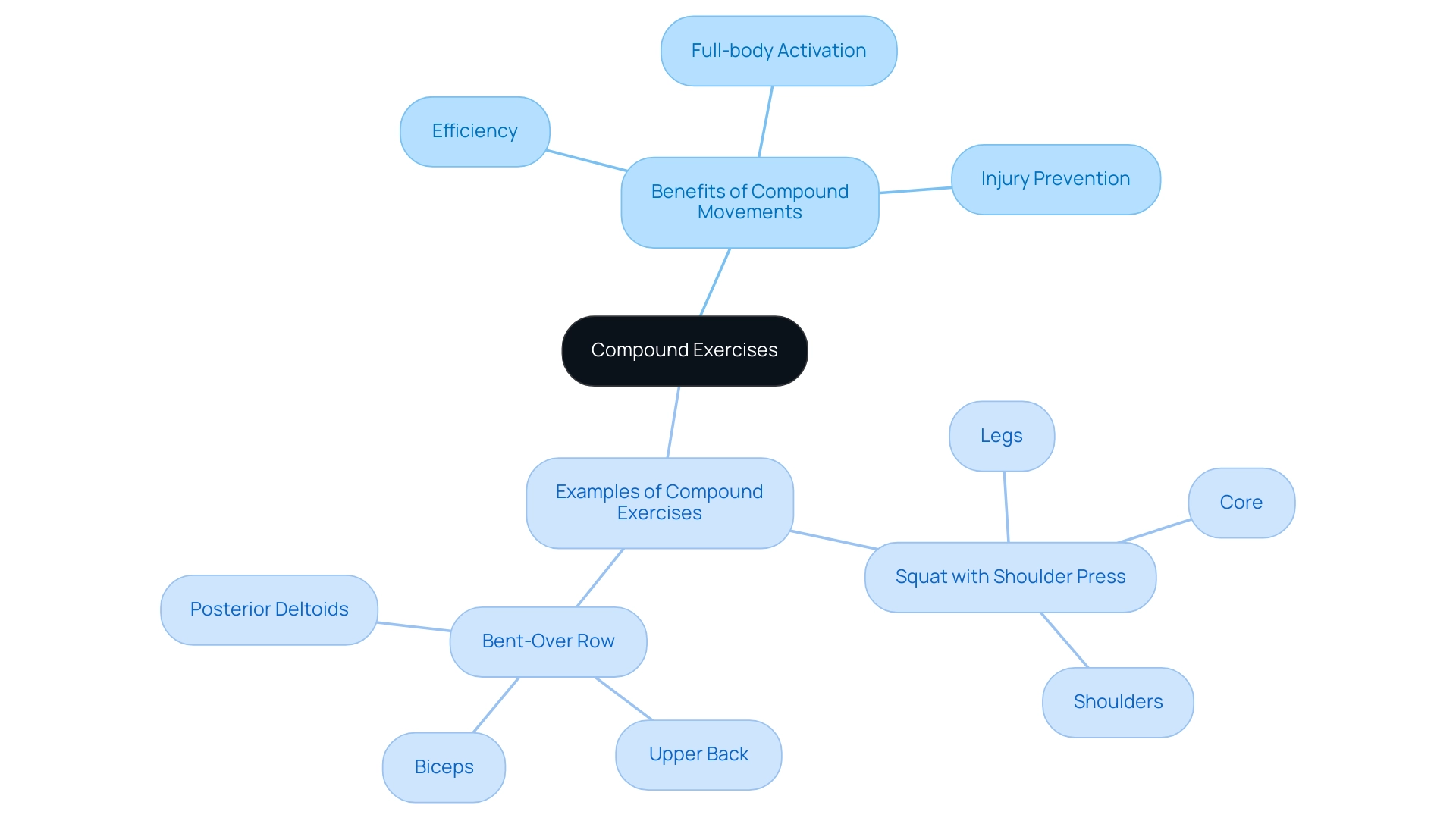
Essential Dumbbell Compound Exercises for a Full-Body Workout
To maximize efficiency in your workouts, integrating full body compound exercises with dumbbells is key. These activities not only improve power but also elevate heart rate, merging the advantages of resistance training with cardio. Here’s a list of must-include movements:
- Dumbbell Squat to Press: Begin by standing with your feet shoulder-width apart, holding dumbbells at shoulder height. As you squat down, keep your core engaged; then, as you rise, press the dumbbells overhead.
- Dumbbell Deadlift: Position your feet hip-width apart and hold dumbbells in front of your thighs. Hinge at your hips to lower the weights toward the ground while keeping a straight back, which improves your posterior chain power.
- Dumbbell Bench Press: While lying on a bench, hold a dumbbell in each hand at chest level. Press the weights upward until your arms are fully extended, then lower them back down with control. This activity is fantastic for developing upper body power.
- Renegade Row: Start in a plank position with a dumbbell in each hand. As you stabilize your body, row one dumbbell towards your hip, then switch sides. This movement not only strengthens your back but also engages your core and improves balance.
- Dumbbell Lunges: Step forward with one leg while holding dumbbells at your sides. Lower your body until your front thigh is parallel to the ground, then push back to standing. This activity improves leg power and coordination.
Incorporating full body compound exercises with dumbbells into your routine can significantly improve overall fitness. According to fitness specialists, full body compound exercises with dumbbells provide the best outcomes for power, size, endurance, fat loss, and athleticism. Assal Arian, a Peloton instructor, states, "All in all, compound lifts give you the best [results] for power, muscle size, endurance, fat loss, athleticism, and aesthetics."
By programming these activities effectively, such as performing 8-15 reps with moderate loads—starting with light dumbbells for beginners as recommended in the case study titled 'Chest-Supported Dumbbell Rows Programming'—you can ensure a comprehensive approach to strength training that is both effective and engaging. Embrace these movements to empower your team’s well-being and fitness journey.
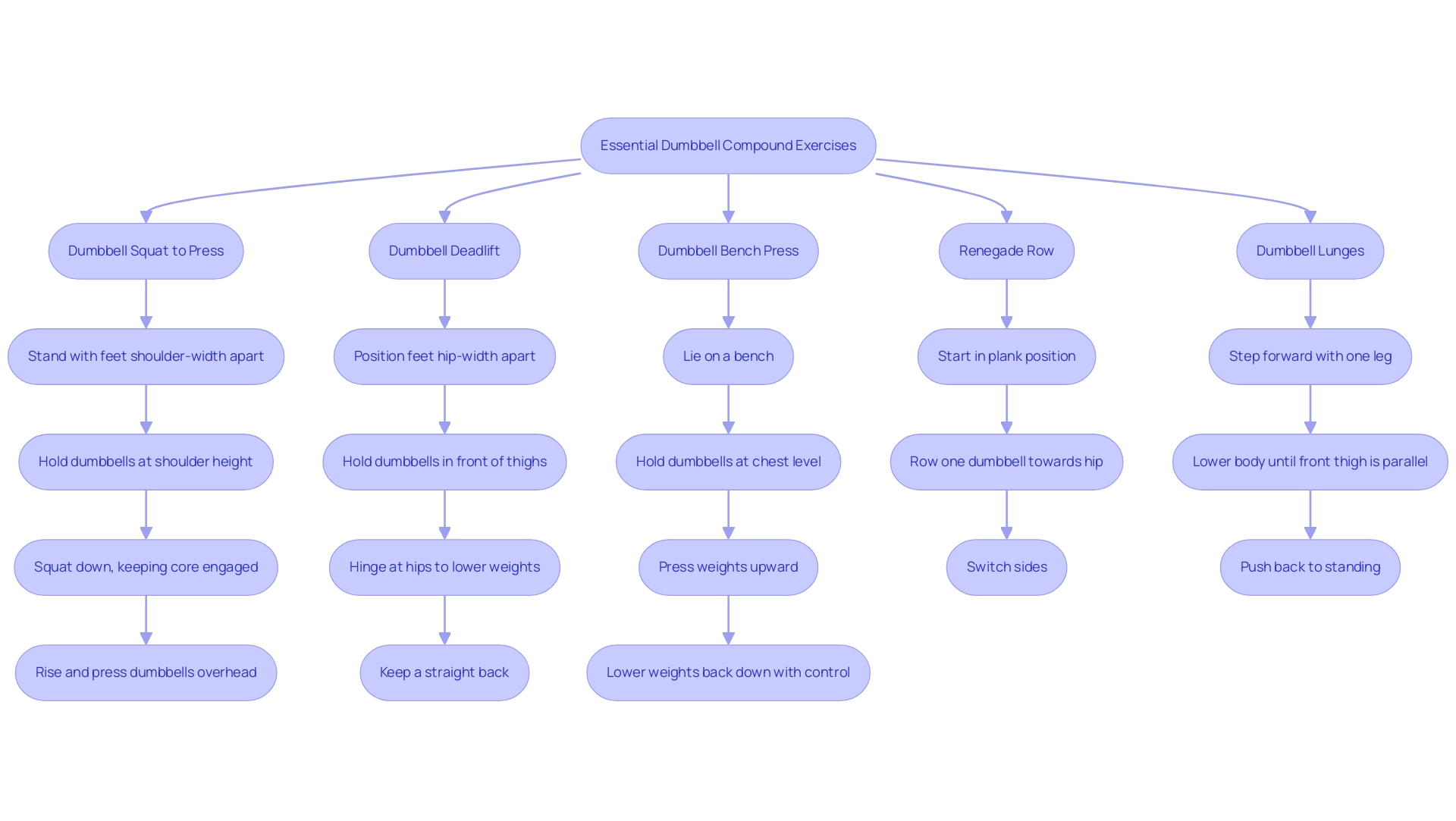
The Benefits of Full-Body Compound Workouts: Efficiency and Strength Building
Incorporating full-body compound exercises into your fitness routine unlocks a wealth of benefits that can significantly enhance overall well-being:
- Time Efficiency: By involving several body groups simultaneously, these routines enable you to accomplish a thorough fitness session in a fraction of the time relative to conventional isolation activities. This efficiency is crucial for busy schedules.
- Increased Power: Compound exercises are renowned for promoting greater gains in power. They require additional energy and involve larger areas of the body, providing a more efficient exercise. Studies suggest that a group of fibers trained with heavy weights (6+ sets) may need 5-6 days to recuperate, rendering these sessions crucial for optimizing strength in a reduced period.
- Enhanced Coordination and Balance: These activities boost your body’s capacity to operate as a cohesive entity, resulting in better coordination and stability. This is particularly beneficial for overall athletic performance and everyday activities.
- Higher Caloric Burn: Engaging multiple muscles simultaneously results in a higher caloric expenditure during exercise. This is a key factor for those aiming for weight management and fat loss, aligning with the latest discussions on common fat loss mistakes. Many individuals overlook the importance of maintaining proper hydration and incorporating nutrient-rich foods, such as dairy, into their diets, which can significantly impact their progress.
- Functional Fitness: Compound movements closely mirror everyday activities, which improves your ability to perform daily tasks with greater ease and efficiency. For instance, Ian, who sought to shorten his full-body exercise routine, discovered that incorporating full body compound exercises with dumbbells not only saved him time but also enhanced his overall strength and functional performance.
In the words of Marc Perry, a Certified Strength and Conditioning Specialist,
Nutrition – unprocessed, nutrient dense foods should be your focus.
Combining a focus on full body compound exercises with dumbbells and proper nutrition, including hydration and dairy intake, can elevate your fitness journey to new heights, ensuring that you not only maximize efficiency but also support your overall health and wellness.
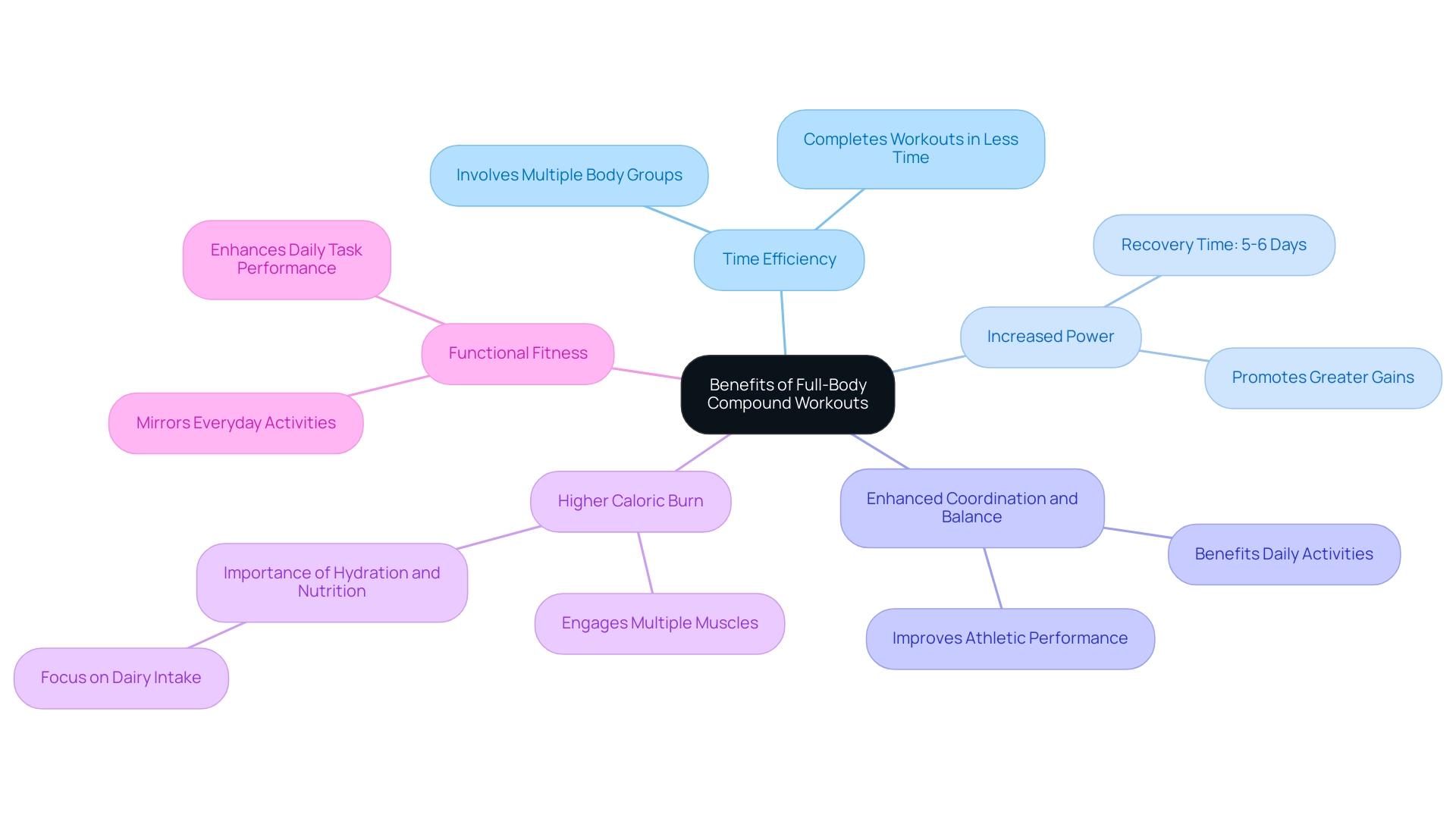
How to Structure Your Full-Body Dumbbell Workout: Tips and Guidelines
To design an impactful full-body dumbbell routine, embrace the following essential strategies:
- Warm-Up: Kick off your session with a dynamic warm-up lasting 5-10 minutes. Engaging in light cardio or dynamic stretches prepares your body and joints for the workout ahead.
- Exercise Selection: Choose 4-6 full body compound exercises with dumbbells that involve multiple muscle groups, ensuring a well-rounded balance between upper and lower body movements. This variety not only boosts strength but also adds to a more visually appealing physique, as well-proportioned form often seems larger than it truly is. Remember, the optical illusion plays a significant role in muscle perception, making it crucial to focus on balanced development.
- Sets and Reps: Aim for 3-4 sets of each exercise, targeting 8-12 repetitions per set. It’s essential to select weights that challenge you during the final repetitions while remaining manageable—this approach fosters progression and builds confidence. For instance, beginners should strive to meet the pull-up strength standards of 3-5 reps with body weight, progressing as they become stronger.
- Rest Intervals: Incorporate 30-60 seconds of rest between sets. This recovery period enables your body to recuperate without sacrificing exercise intensity, ensuring you maintain momentum throughout your session.
- Cool Down: Conclude with a cool-down period that includes static stretches. This practice not only promotes flexibility but also aids in the recovery process, allowing your body to adapt and grow stronger.
By adhering to these guidelines, you will cultivate an effective and balanced workout routine incorporating full body compound exercises with dumbbells that fosters not just physical well-being but also a sense of accomplishment and motivation. Additionally, understanding how to reduce training time without compromising results can encourage more individuals to engage in strength training, aligning with the goal of maximizing efficiency.
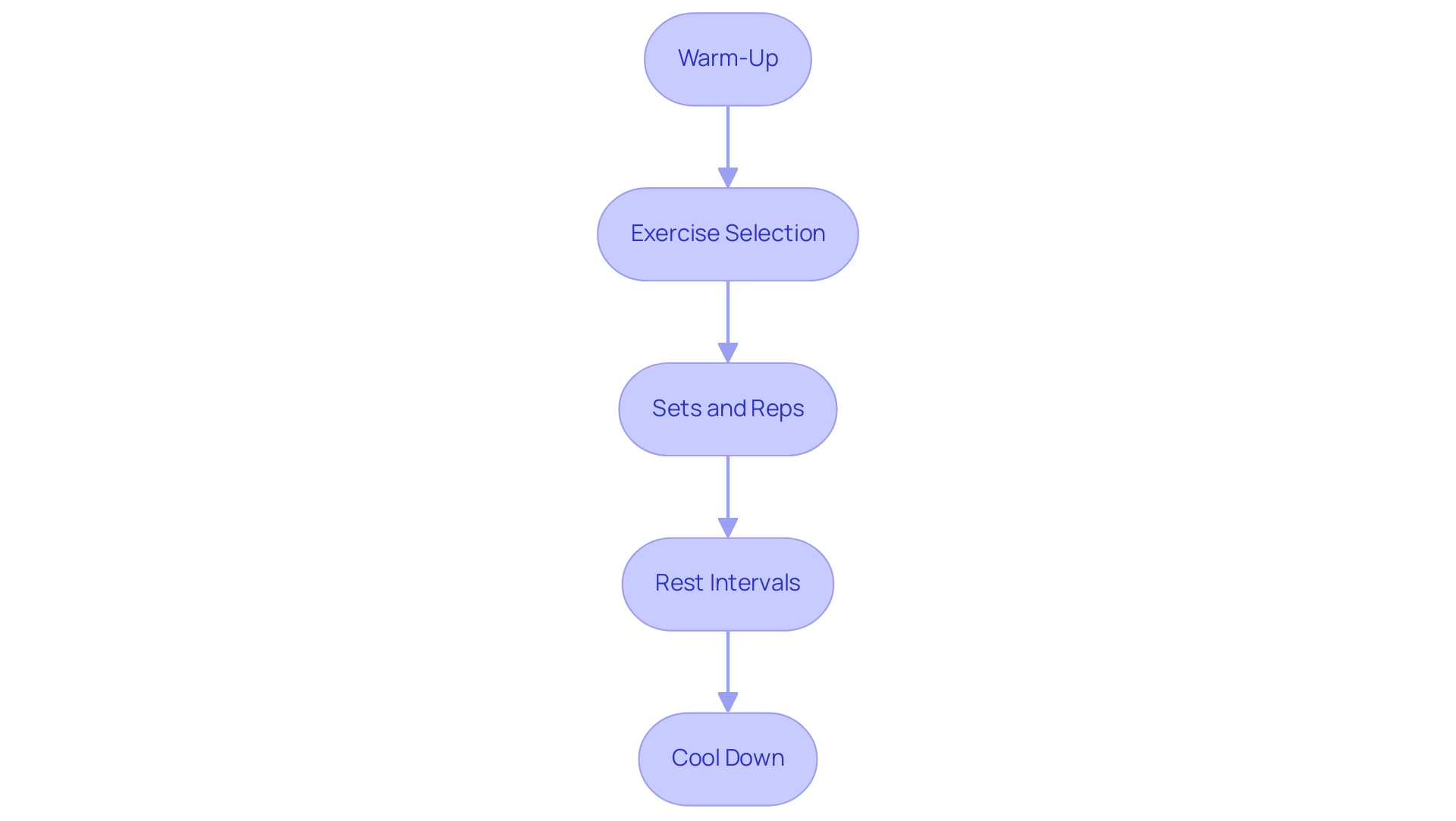
Maximizing Your Workout: Common Mistakes and Expert Tips for Dumbbell Exercises
To truly maximize the effectiveness of your dumbbell compound exercises, it’s essential to steer clear of these common pitfalls:
-
Prioritize Proper Form: Always remember that technique trumps lifting heavier weights. Poor form not only increases the risk of injury but also diminishes the exercise's effectiveness. As fitness expert Carmelo Bosco aptly stated,
Training is an art based on science, and training without evaluation is an itinerary without destination.
Regularly assess your form to ensure you’re on the right path.
-
Never Skip Warm-Up and Cool Down: These vital components should never be overlooked. Skipping warm-ups can lead to muscle strain, while neglecting cool downs may hinder recovery. Incorporate both into your routine for optimal results.
-
Wear Appropriate Shoes: Ensure you are wearing shoes that provide good traction and support. Proper footwear can protect your feet and enhance stability, reducing the risk of injury during weightlifting.
-
Start with Manageable Weights: It’s tempting to lift heavy right away, but beginning with weights that you can handle will allow you to perfect your form. Once you master the basics, you can gradually increase the weight.
-
Master Your Breathing Techniques: Proper breathing is crucial for maintaining stability and maximizing strength. Exhale during the exertion phase and inhale while lowering the weights to enhance your performance.
-
Commit to Consistency: Irregular exercise routines can drastically affect your results. Treat your exercise routine with the same importance as any other critical appointment. Consistency is key to achieving lasting fitness goals.
-
Plan Your Training: As highlighted in the case study titled "Planning to Fail by Failing to Plan," a lack of a structured training plan can hinder progress in weight training. A well-crafted training plan is crucial for balanced muscle development and motivation, directing you through your exercises.
By remaining vigilant about these strategies and steering clear of common mistakes, you can significantly enhance your workout experience with full body compound exercises with dumbbells and make meaningful strides toward your fitness objectives. Additionally, remember to incorporate strength training exercises at least two times a week, as recommended by the U.S. Department of Health and Human Services, to maximize your fitness gains.
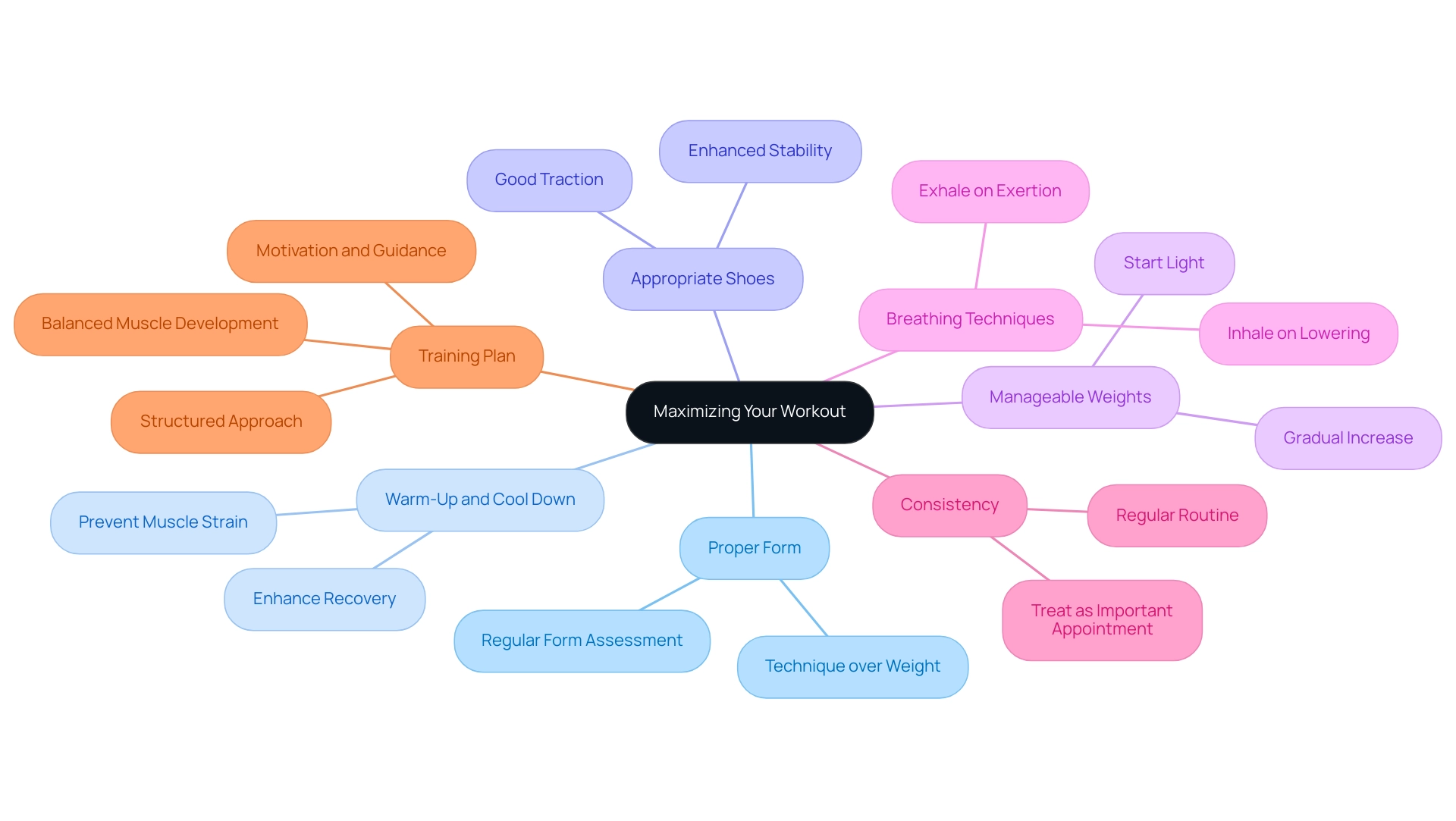
Conclusion
Incorporating compound exercises into fitness routines offers a multitude of benefits that can significantly enhance both individual and team well-being. These dynamic movements not only engage multiple muscle groups, promoting efficiency and strength building, but also save valuable time for those with busy schedules. By prioritizing compound exercises such as:
- Dumbbell Squat to Press
- Bent-Over Row
- Renegade Row
individuals can achieve comprehensive workouts that yield impressive results in strength, coordination, and caloric burn.
To maximize the effectiveness of these workouts, it is essential to adhere to proper techniques, prioritize warm-ups and cool-downs, and avoid common pitfalls that can hinder progress. By focusing on form, consistency, and structured training plans, fitness enthusiasts can cultivate a sustainable path towards their fitness goals.
Ultimately, embracing these strategies not only fosters personal health but also contributes to a resilient and motivated workforce. As organizations encourage a culture of health, integrating compound exercises into training regimens will empower teams to thrive both physically and mentally, paving the way for a healthier and more productive future. Now is the time to take action and prioritize these effective workouts for the well-being of everyone involved.




